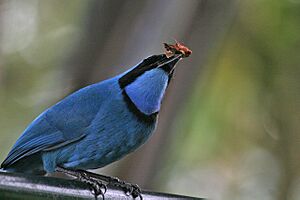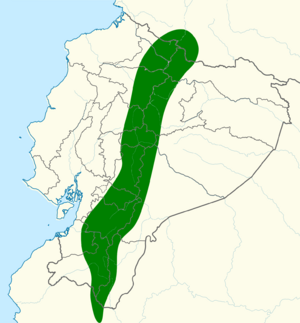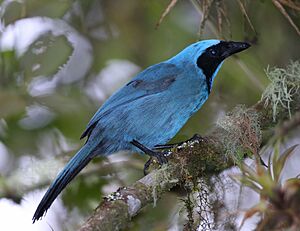Turquoise jay facts for kids
Quick facts for kids Turquoise jay |
|
|---|---|
 |
|
| In the Bellavista Cloud Forest Reserve, Ecuador | |
| Conservation status | |
| Scientific classification | |
| Genus: |
Cyanolyca
|
| Species: |
turcosa
|
 |
|
| Synonyms | |
|
|
The turquoise jay (Cyanolyca turcosa) is a beautiful blue bird that belongs to the Corvidae family, which also includes jays, magpies, and crows. This bird has bright blue feathers, a black face mask, and a black collar. You can only find the turquoise jay in South America, specifically in southern Colombia, Ecuador, and northern Peru.
These jays love living in humid places like mountain evergreen forests and small, dense forests. They eat many different things, including insects, berries, eggs, and even the young birds of other species. Turquoise jays do not migrate, meaning they stay in the same area all year. They often travel together in groups with other types of birds.
Contents
About the Turquoise Jay
Bird Families: Passeriformes and Corvidae
The group of birds called Passeriformes is often known as "perching birds." It is one of the largest and most varied groups of birds in the world. You can find these birds almost everywhere, except Antarctica. They are most common in warm, tropical areas. These birds come in many sizes, from tiny ones weighing just a few grams to larger ones over a kilogram. Many of them are known for their colorful feathers and beautiful songs.
The Corvidae family is part of the Passeriformes group. This family includes jays, magpies, and crows. Most birds in this family are strongly built with thick beaks. They are some of the biggest birds in the perching bird group. Male and female birds in this family usually look the same. Corvids often have loud, harsh calls and are very social. Birds in a group will help each other, and a pair often stays together for life. Corvids are also very smart and good at finding food. There are more than 120 known species in the Corvidae family.
Other Jays That Look Similar
Several other jays look a bit like the turquoise jay. These include the beautiful jay, the black-collared jay, and the white-collared jay.
The black-collared jay lives in the same areas of northwestern South America as the turquoise jay. However, the black-collared jay is less green and has a much longer tail. The white-collared jay also lives in northwestern South America. It looks different from the turquoise jay because it has a white patch on its forehead, a black underside to its tail, a thin white collar, and a darker blue color overall.
The beautiful jay is a rare bird found only in a small part of the western Andes mountains between Colombia and Ecuador. It is darker in color, smaller, and does not have a black collar like the turquoise jay. The turquoise jay does not have any subspecies, meaning there are no different types of turquoise jays.
What Does a Turquoise Jay Look Like?
Male and female turquoise jays look exactly alike. Adult turquoise jays are mostly a bright blue-green color. This color can change depending on how the light hits their feathers. The underside of their wings and tail are black.
The turquoise jay has a thick, black mask on its face that reaches its ears. This mask connects to a thin, black collar that goes around its throat but not around the back of its neck. The front part of the turquoise jay's head is very light, almost white. Its eyes are brown, and its legs, feet, and beak are all black. Young turquoise jays are not as brightly colored and do not have the thin, black collar.
Here are some measurements for the turquoise jay:
- Total Length: 32 cm
- Wing Length: 137 mm
- Tail Length: 142 mm
- Bill Length: 34 mm
- Tarsus Length: 39 mm
The main sound the turquoise jay makes is a short, whistling sound that goes down in pitch. They often make this sound in a series. The whistle is loud and sounds a bit hissy. Turquoise jays can also make popping, squeaking, hissing, and static-like noises.
Where Do Turquoise Jays Live?
The turquoise jay lives only in South America. You can find them along the western Andes Mountains, from southern Colombia to northern Peru. They usually live at elevations between 2,000 and 3,000 feet, depending on the country. In Colombia, they are typically found between 2,600 and 3,000 feet. In Ecuador, they can be found as low as 2,000 feet.
These birds prefer humid places with lots of tangled trees and bushes. They live in tall, mountain evergreen forests and short, dense elfin forests with thick plants. They can also be found in areas where the habitat has been slightly changed by humans. The turquoise jay is listed as "least concern" for its conservation status. This means its populations are quite stable in its natural range. This bird is considered common in the areas where it lives.
How Turquoise Jays Behave
What Do Turquoise Jays Eat?
The turquoise jay is an omnivore, meaning it eats both plants and animals. We don't know a lot about their exact diet, but we do know they eat insects, berries, eggs, and the young birds of other species. Like other jays, the turquoise jay searches for food in the middle and top parts of trees, looking closely at the plants as it goes.
Reproduction and Nesting
Not much is known about how turquoise jays breed. Their nests are usually made of moss and are built in the forks of branches near the tops of trees. The areas where nests are found are often isolated and located in the center of the tree. More than one bird helps to build the nest and care for the young. The male jay will usually feed and take care of the female while she is sitting on the eggs.



